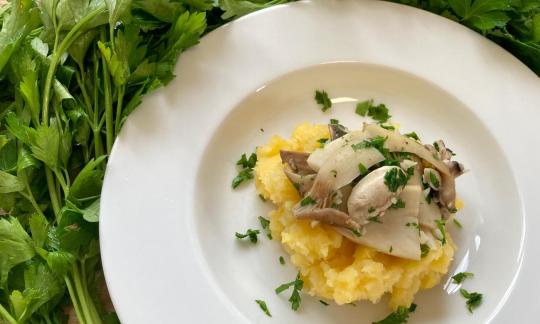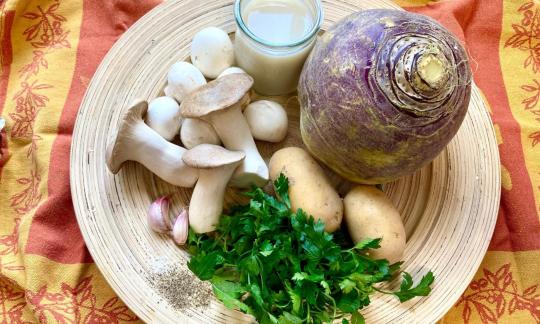Oil-free steamed mushrooms with parsley and turnip puree
vegan
Ingredients (for servings, )
| For the turnip puree | |
|---|---|
| 25 oz | Swedes, raw (organic?) |
| 5 ½ oz | Potatoes, raw (organic?) |
| 70 ml | Oat milk (oat drink, raw?, organic?) (2.5 oz) |
| 70 ml | Drinking water, raw (organic?) (2.5 oz) |
| For the mushroom pan | |
| 8 ½ oz | Raw king oyster mushrooms (organic?) |
| 8 ½ oz | Cultivated mushrooms, raw (organic?) |
| 4 cloves | Garlic (organic?) (0.42 oz) |
| 1 oz | Parsley, fresh, raw (leaf parsley, parsley) |
| 100 ml | Oat milk (oat drink, raw?, organic?) (3.5 oz) |
| 1 dash | Table salt (table salt, raw?, organic?) (0.01 oz) |
| 1 tsp, ground | Black pepper (organic?, raw?) (0.08 oz) |
Equipment
- hand-held blender / immersion blender
- vegetable peeler
- skillet (frying pan)
- stove
- saucepan
- potato ricer or potato masher
Type of preparation
- cook
- chop or grind
- sauté
- squeeze
- season to taste
- purée
- remove the skin
- peel
Preparation
For the turnip puree
Peel the turnips and potatoes and cut them into small cubes. Put them together in a pot with plenty of salted water and bring to the boil. Cook for about 20 minutes until the vegetables are soft.Meanwhile, proceed to the next step.
For the mushroom pan
Clean the oyster mushrooms and button mushrooms, cut off the ends and cut into slices. Peel the garlic and finely dice or press. Wash the parsley and chop finely.Mushrooms: You can also use other mushrooms, such as chanterelles or just button mushrooms .
Finish the swede puree
Drain the vegetables, collecting the cooking water. Add about 50-100 ml of the cooking water (for 4 people) to the turnip and potato mixture and mash the vegetables. Add the oat milk and mix. If necessary, add more oat milk or cooking water until the desired consistency is achieved. Season with salt.Cover the pot and set aside until the mushroom pan is ready.
Making oat milk: Information on making your own raw vegan oat milk can be found under the "Make Your Own" section in the following link: Oat milk.
Finishing the Mushroom Pan
Pour the oat milk and garlic into a pan and bring to the boil. After about a minute, add the oyster mushrooms and let them simmer with the lid closed for about 3 minutes, stirring occasionally.If necessary, add some oat milk or water.
Add the mushrooms and a little salt and simmer for another 2 minutes. Finally, add the parsley and season with salt and pepper.
Arrange and serve
Arrange the swede puree on a plate and distribute the mushrooms on top.
|
Nutritional Information per person
Convert per 100g
|
2000 kcal | |
|---|---|---|
| Energy | 153 kcal | 7.7% |
| Fat/Lipids | 1.5 g | 2.1% |
| Saturated Fats | 0.26 g | 1.3% |
| Carbohydrates (inc.dietary fiber) | 32 g | 11.9% |
| Sugars | 12 g | 13.7% |
| Fiber | 7.5 g | 29.8% |
| Protein/Albumin | 7.4 g | 14.8% |
| Cooking Salt (Na:104.0 mg) | 264 mg | 11.0% |
| Essential micronutrients with the highest proportions | per person | 2000 kcal | |
|---|---|---|---|
| Vit | Vitamin C (ascorbic acid) | 64 mg | 80.0% |
| Elem | Potassium, K | 1'232 mg | 62.0% |
| Vit | Vitamin K | 39 µg | 52.0% |
| Min | Copper, Cu | 0.45 mg | 45.0% |
| Vit | Vitamin B3 (Niacin) | 7.3 mg | 45.0% |
| Vit | Vitamin B9, B11 (Folate, as the active form of folic acid) | 90 µg | 45.0% |
| Vit | Vitamin B7 (Biotin, ex vitamin H) | 21 µg | 42.0% |
| Vit | Vitamin B2 (Riboflavin) | 0.53 mg | 38.0% |
| Vit | Vitamin B6 (pyridoxine) | 0.50 mg | 36.0% |
| Min | Manganese, Mn | 0.64 mg | 32.0% |
Detailed Nutritional Information per Person for this Recipe
The majority of the nutritional information comes from the USDA (US Department of Agriculture). This means that the information for natural products is often incomplete or only given within broader categories, whereas in most cases products made from these have more complete information displayed.
If we take flaxseed, for example, the important essential amino acid ALA (omega-3) is only included in an overarching category whereas for flaxseed oil ALA is listed specifically. In time, we will be able to change this, but it will require a lot of work. An “i” appears behind ingredients that have been adjusted and an explanation appears when you hover over this symbol.
For Erb Muesli, the original calculations resulted in 48 % of the daily requirement of ALA — but with the correction, we see that the muesli actually covers >100 % of the necessary recommendation for the omega-3 fatty acid ALA. Our goal is to eventually be able to compare the nutritional value of our recipes with those that are used in conventional western lifestyles.
| Essential fatty acids | per person | 2000 kcal |
|---|---|---|
| Alpha-Linolenic acid; ALA; 18:3 omega-3 | 0.10 g | 5.0% |
| Linoleic acid; LA; 18:2 omega-6 | 0.54 g | 5.0% |
| Essential amino acids | per person | 2000 kcal |
|---|---|---|
| Tryptophan (Trp, W) | 0.06 g | 25.0% |
| Threonine (Thr, T, irreversibly transaminated) | 0.20 g | 22.0% |
| Valin (Val, V) | 0.32 g | 20.0% |
| Isoleucine (Ile, I) | 0.18 g | 14.0% |
| Lysine (Lys, K, irreversibly transaminated) | 0.25 g | 13.0% |
| Leucine (Leu, L) | 0.28 g | 12.0% |
| Phenylalanine (Phe, F) | 0.19 g | 12.0% |
| Methionine (Met, M) | 0.08 g | 8.0% |
| Vitamins | per person | 2000 kcal |
|---|---|---|
| Vitamin C (ascorbic acid) | 64 mg | 80.0% |
| Vitamin K | 39 µg | 52.0% |
| Vitamin B3 (Niacin) | 7.3 mg | 45.0% |
| Vitamin B9, B11 (Folate, as the active form of folic acid) | 90 µg | 45.0% |
| Vitamin B7 (Biotin, ex vitamin H) | 21 µg | 42.0% |
| Vitamin B2 (Riboflavin) | 0.53 mg | 38.0% |
| Vitamin B6 (pyridoxine) | 0.50 mg | 36.0% |
| Vitamin B1 (Thiamine) | 0.29 mg | 27.0% |
| Vitamin B5 (Pantothenic acid) | 1.4 mg | 24.0% |
| Vitamin E, as a-TEs | 0.81 mg | 7.0% |
| Vitamin A, as RAE | 32 µg | 4.0% |
| Vitamin D | 0.12 µg | 3.0% |
| Vitamin B12 (Cobalamin) | 0.02 µg | 1.0% |
| Essential macroelements (macronutrients) | per person | 2000 kcal |
|---|---|---|
| Potassium, K | 1'232 mg | 62.0% |
| Phosphorus, P | 194 mg | 28.0% |
| Magnesium, Mg | 73 mg | 19.0% |
| Calcium, Ca | 109 mg | 14.0% |
| Sodium, Na | 104 mg | 13.0% |
| Essential trace elements (micronutrients) | per person | 2000 kcal |
|---|---|---|
| Copper, Cu | 0.45 mg | 45.0% |
| Manganese, Mn | 0.64 mg | 32.0% |
| Iron, Fe | 3.0 mg | 22.0% |
| Zinc, Zn | 1.7 mg | 17.0% |
| Selenium, Se | 7.6 µg | 14.0% |
| Iod, I (Jod, J) | 16 µg | 11.0% |
| Fluorine, F | 14 µg | < 0.1% |
The steamed oyster mushrooms and button mushrooms with parsley and swede puree do not require any oil and are easy to make.
Nutrient profile: According to GDA guidelines, one portion of this low-calorie recipe covers about 50% of the daily requirement of vitamins C and K and the trace element copper. The ratio of omega-6 to omega-3 fatty acids is 5:1, which is within the maximum recommended ratio.
You can find further information on this topic at the following link: Vegans often eat unhealthily. Avoidable nutritional errors .
Swede: In Germany, traditionally only the yellow-fleshed root tubers, which weigh up to 1.5 kg, are used in cooking, while the white-fleshed varieties are used as fodder turnips. In addition to carbohydrates, swedes also contain large amounts of vitamin C, beta carotene and calcium. However, the tuber consists mainly of water, is therefore almost fat-free and is considered a low-calorie vegetable.
Oyster mushrooms: The oyster mushrooms (Pleurotus), also known as king oyster mushrooms or king oyster mushrooms, are a genus of mushrooms from the family of oyster mushrooms. Oyster mushrooms have a delicate aroma. Like porcini mushrooms, oyster mushrooms are available in brown or pale colors, although the flesh of the brown oyster mushroom has a porcini-like consistency. The aroma of the oyster mushroom is also similar to that of the porcini mushroom. It is also cultivated. Like the button or porcini mushroom, it can also be eaten raw.
Mushrooms: The button mushroom is the most common cultivated mushroom. The flesh of the round mushroom is white and firm, the taste mild. The brown button mushroom is a special variety that is less sensitive to pressure and has a more intense flavor than the white mushroom. Unlike wild mushrooms, cultivated mushrooms can be purchased in stores all year round.
Oat milk: Oat milk (EU: oat drink) is made from oats and water. Oat milk is suitable as a cow's milk substitute and is easy to prepare yourself (see "Alternative preparation").
Parsley: Parsley usually only plays a supporting role in a dish. Parsley is a source of flavonoids, antioxidants and vitamins, especially vitamins K, C and A, which makes this culinary herb suitable for more than just a garnish. There is curly leaf parsley, root parsley and flat-leaf parsley. The latter is considered spicier than the curly leaf parsley and root parsley is the strongest in taste. All parts of the parsley plant have a strong, spicy-bitter aroma, although the often less noticed stems are particularly aromatic. From a medicinal point of view, parsley has a cleansing, disinfectant, diuretic, antispasmodic and expectorant effect.
Amount of salt: We have deliberately not given any information on the amount of salt, as individual needs vary greatly. You decide for yourself, but we recommend keeping the salt content as low as possible. It takes around 3 months to get used to a lower salt content, but you will also benefit from this change in terms of taste. You can find more information on this topic in the book we describe in detail: Salt Sugar Fat by Michael Moss.
Puree: Instead of the turnip, you can also use pure mashed potatoes or potato-parsley root puree.
Mushrooms: You can also use other mushrooms, such as chanterelles or just button mushrooms .
Making oat milk: Information on making your own raw vegan oat milk can be found under the "Make Your Own" section in the following link: Oat milk.






